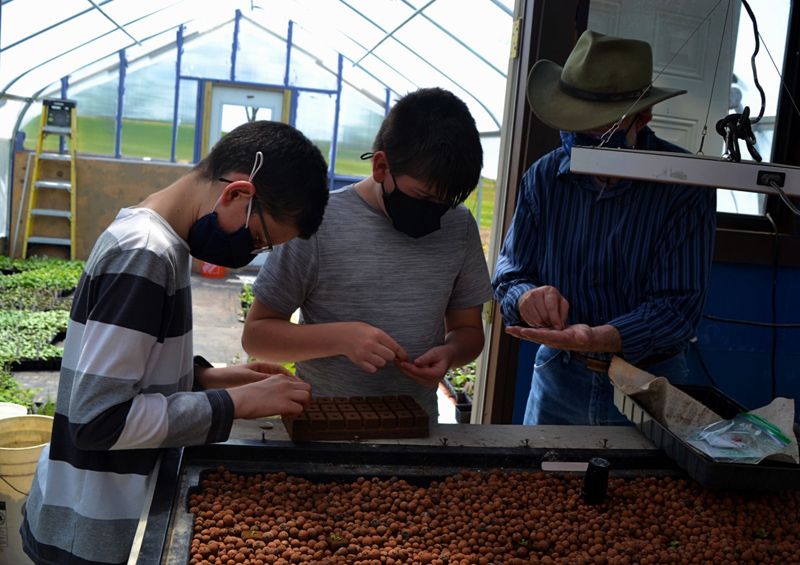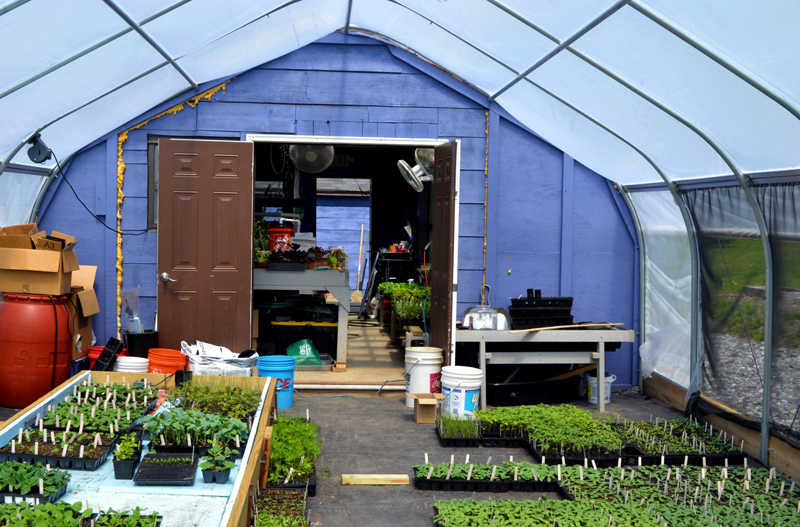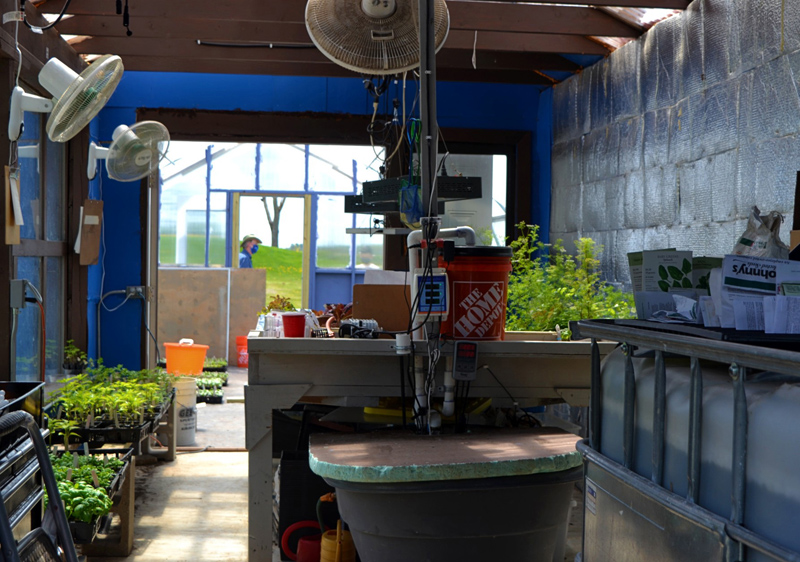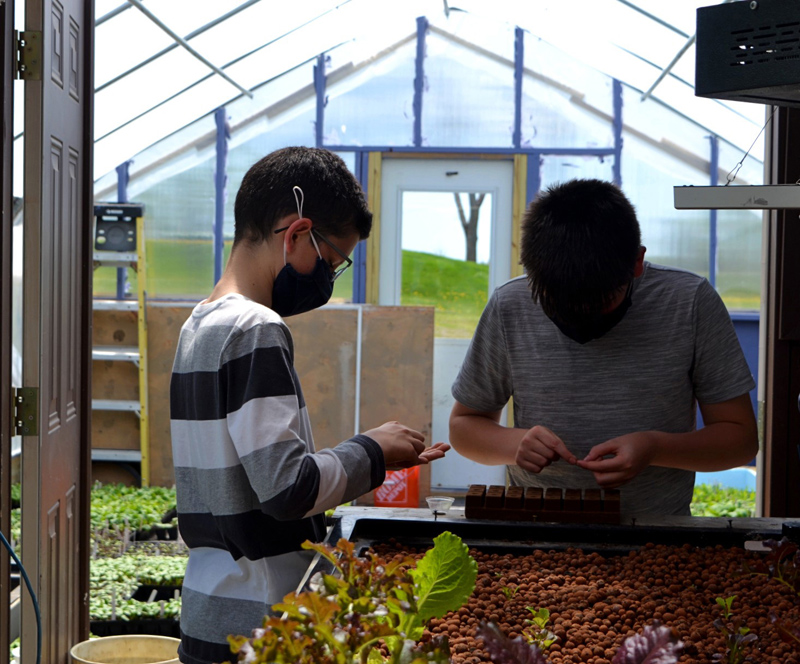
Tim Davis, educational technician who helps run the aquaponics and horticulture program at Whitefield Elementary School, teaches seventh grade students Donovan Thompson (left) and Benjamin Sullivan (right) how to grow lettuce. (Nettie Hoagland photo)
For students in grades six through eight at Whitefield Elementary School, the school’s aquaponics and horticulture program is reconnecting them to their agrarian community.
“We live in a vibrant agricultural town, but lots of students don’t have the chance or knowhow to grow their own food,” said Tim Davis, an educational technician who helps run the aquaponics and horticulture program with Karen McCormick, sixth through eighth grade science and social studies teacher.
After a long winter of sowing seeds, planting, transplanting, and harvesting, the students will sell their seedlings at their plant sale from 9 a.m. to noon, Friday, May 21 and Saturday, May 22.
The students will sell a variety of seedlings including lupine, sunflower, cucumber, tomato, green pepper, hostas, parsley, basil, zucchini, winter squash, summer squash, and pumpkins.
The full rotation of sowing seeds to selling seedling helps students see the advantages growing their own food has on the world around them, Davis said.

The recently installed hoop house has increased the space for seedlings at Whitefield Elementary School. (Nettie Hoagland photo)
Profits from the plant sale rotate back into the school’s aquaponics and horticulture program, which has expanded as part of the middle school students’ science and social studies curriculum.
“Before heading out to the greenhouse, the students circle up and choose what task they want to take on — watering, transplanting, feeding the fish, harvesting the lettuce, filling the trays — every student has a job,” McCormick said.
The big focus is now on experimenting with and improving the aquaponics system, where aquatic life, such as fish, supports the cultivation of hydroponically grown plants, or plants grown in water without soil.
Former educational technician James Willigar started the Aquaponics-Based Learning Environment program with teacher Sally Allen, in 2015, as an alternative way to provide structured educational support to students with autism or behavioral or emotional challenges.
When Willigar left at the end of the 2019 school year, McCormick inherited the school’s greenhouse, which houses the aquaponics system, and the expansive aquaponics and horticulture program.

The outdoor greenhouse and hoop house at Whitefield Elementary School. (Nettie Hoagland photo)
“I didn’t have any previous experience with aquaponics, but as a science teacher it wasn’t that big of a leap,” McCormick said.
Last year, when Davis was hired as an educational technician, he entered his new role with decades of experience in the horticulture and agriculture field.
“It’s been exciting to see the students get so into working with their hands, and working with these systems that connect them to food,” Davis said. “Being involved with the entire process of food production encourages the students to eat fresh vegetables too.
One of the quickest yield vegetables grown out of an aquaponics system is lettuce, owing to the optimal nutrient concentrations in the water.
“Aquaponics is a really efficient way to produce a lot of food in a small footprint,” Davis said.
The students have 100 plants of lettuce growing in the beds, which they hope to supply their school cafeteria staff with. Last year, they helped start a salad bar with the hydroponically grown lettuce.
“We’ve had parents say that their children are more willing to eat fresh produce and lend a hand with the gardening work at home,” McCormick said.

A greenhouse at Whitefield Elementary School houses the school’s aquaponics system. (Nettie Hoagland photo)
McCormick said that while the aquaponics and horticulture program has been around for several years, this is their most successful year.
At the end of the 2018-2019 school year, the school received a grant from the Perloff Family Foundation to install a hoop house, a non-engineered greenhouse used for starting seedlings and growing plants year-round.
“With our aquaponics system taking up most of the greenhouse, we needed another space for growing seedlings,” McCormick said.
With the assistance of parents and other community members, the students helped McCormick and Davis assemble the hoop house to get it ready for this school year.
“We had students working on the ground work, raising the hoops, and even covering the roof,” Davis said. “We’ve had parents, who are engineers and plumbers, volunteer their time to fix any maintenance issues.”

Seventh grade students Donovan Thompson (left) and Benjamin Sullivan (right) count lettuce seeds to plant using the Whitefield Elementary School’s aquaponics system. (Nettie Hoagland photo)
Not far from the greenhouse and hoop house, the students continue their long-standing tradition of growing pumpkins to sell to the community in support of the parent-teacher association. One half of the 60-by-100-foot plot is an experiment with a no-till technique for growing crops without destroying the soil through tillage, as suggested by a local farmer.
“In the fall, we had pre-K and kindergarteners out harvesting the pumpkins with the eighth graders — it was really special to see,” McCormick said.
In addition to raising funds to continue the aquaponics and horticulture program, the plant sale teaches students that growing plants — with or without soil — is about serving the local community and ultimately, giving back to their own food growing efforts.
“There’s still lots of room for discovery and improvement with our aquaponics and horticulture program — we can’t depend on the school budget to fund all of our expenditures,” McCormick said.






